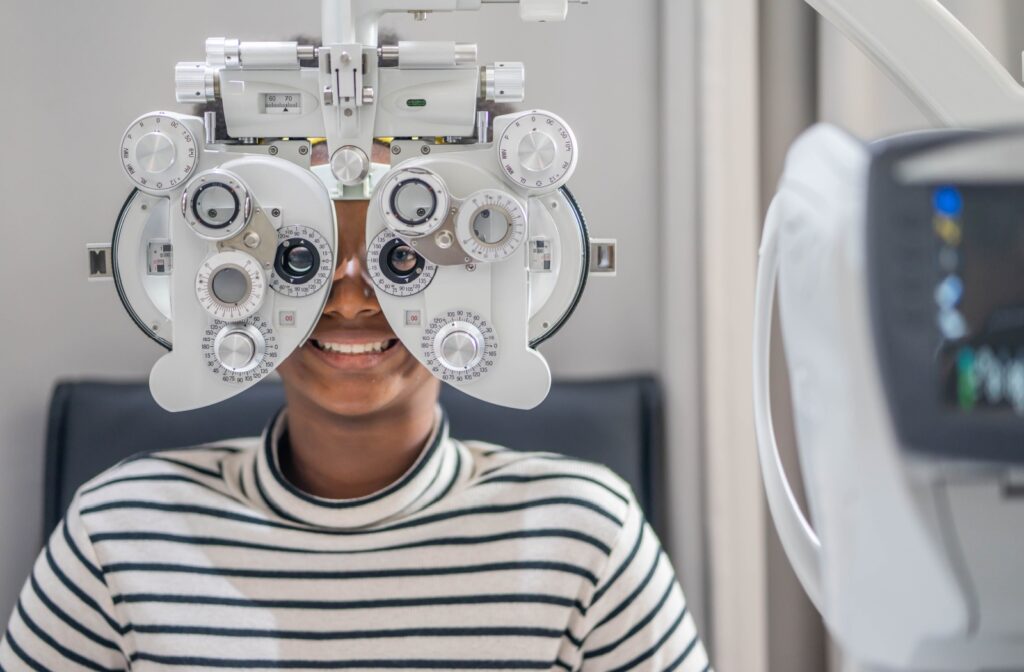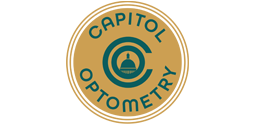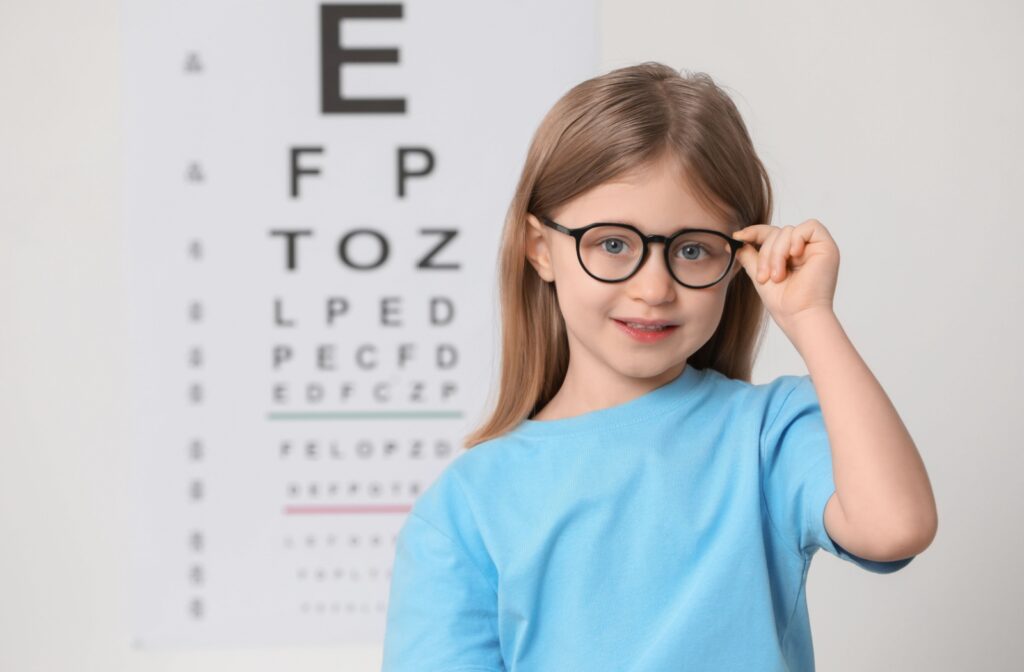An eye exam can feel like a bit of a mystery, especially if it’s been a while since your last one. You might wonder what all those machines do or why we ask you to follow the little red dot.
We want to pull back the curtain and show you just how simple and informative your visit for a comprehensive eye exam can be. Whether you’re due for a check-up or looking for a new pair of glasses or contact lenses, we’re here to make the process clear and comfortable.
A comprehensive eye exam is a straightforward, personalized process that checks your vision clarity and the complete health of your eyes. From start to finish, each step helps us understand your unique visual needs and how to help you see your world more clearly.
What Happens Before Your Eye Exam Starts
Your eye exam begins before you sit in the exam chair. We begin by getting to know you and understanding your vision needs through a detailed history and initial testing.
Your Medical History Review
We’ll chat about your health background because your eyes connect to your overall wellness in surprising ways. This conversation helps us understand what to look for during your exam.
We’ll cover several important questions, such as:
- General health conditions
- Previous eye problems or surgeries
- Family history of eye diseases
- Current medications & supplements
- Lifestyle factors like screen time & work environment
Pre-Testing with Innovative Technology
Before we begin the main exam, we use modern technology to obtain baseline measurements of your eyes. These tests are quick and painless—think of them as a preview of your eye health. Visual field testing helps us detect blind spots and monitor for conditions like glaucoma.
Our pre-testing includes:
- Autorefractor measurements
- Visual field testing
- Optos retinal imaging
- Eye pressure checks
Step-by-Step Eye Exam Process at Capitol Optometry
Now comes the main event — the actual eye exam. We follow a logical sequence that builds upon each test, providing a comprehensive picture of your vision and eye health.
Visual Acuity Testing
The visual acuity test is the classic “read the eye chart” test that you probably remember from school. You’ll read letters or symbols while wearing your current glasses or contacts to see how clearly you can see at different distances.
We’re checking whether you can see 20/20, which means you can read at 20 feet what a person with normal vision can read at that distance. If you can’t quite get there, don’t worry—we’ll figure out exactly what prescription you need.
Binocular Vision Testing
Your eyes need to work as a team, and this test checks how well they coordinate with each other. We’ll assess your eye alignment, focusing ability, and tracking skills.
If your eyes don’t team up properly, you might experience headaches, eye strain, or difficulty reading. We can diagnose a condition called binocular vision dysfunction and help you find effective solutions.
Color Vision & Depth Perception Tests
We’ll screen for color blindness using special charts—this test is especially important for young males or anyone with a family history of color vision problems. We’ll also assess your depth perception to ensure you can accurately judge distances and perceive objects in 3D.
These tests help us understand how you experience the visual world around you. Good depth perception is crucial for driving, sports, and many daily activities.
The Refraction Process: “Which Is Better, 1 or 2?”
Here’s where you’ll hear the famous question that every eye doctor asks. During refraction, we fine-tune your prescription by having you compare different lens options while looking at the eye chart.
The comparison process helps us check for nearsightedness, farsightedness, and astigmatism. We’ll flip through different lenses and ask you to choose which one makes the letters look clearer and sharper.
How Your Eye Doctor Determines Your Prescription
The refraction process is part science, part art. We use your responses to fine-tune the exact prescription that provides you with the clearest, most comfortable vision.
We take our time during this step because getting your prescription right makes a huge difference in how you see and feel. Your comfort and clarity are our top priorities.

Advanced Eye Health Screening & Retinal Exams
Beyond checking your vision, we also examine the health of your eyes themselves. These tests help us catch problems early, often before you notice any symptoms.
Slit Lamp Examination
Using a special microscope, we examine the front part of your eye in detail. This includes your cornea, iris, and lens—all the structures that help focus light into your eye.
The slit lamp helps us detect issues such as cataracts, infections, or dry eye. It’s completely painless and gives us a magnified view of your eye’s surface structures.
Comprehensive Retinal Screenings
Here’s something that sets our practice apart—we include retinal screenings on all of our patients. We utilize Optos imaging technology to obtain detailed images of your retina, and we may also dilate your pupils for a more thorough examination. Dilated eye exams are essential for detecting eye diseases before symptoms appear.
Comprehensive retinal screening enables us to examine your retina, optic nerve, and blood vessels within your eye. We can spot early signs of diabetes, macular degeneration, glaucoma, and other serious conditions. Retinal imaging utilizes innovative digital cameras to capture detailed images of the interior of your eye.
Peripheral Vision Testing
We check your side vision to make sure you can see objects outside your direct line of sight. This test is particularly important for detecting glaucoma, which can cause gradual vision loss that you might not notice at first.
Good peripheral vision is also crucial for driving safely and navigating your environment confidently.
How Often Should You Get an Eye Exam?
Regular eye exams are essential and should be a part of your regular wellness routine. Depending on your age or risk factors, you may need one or more exams per year.
The AOA recommends the following eye exam if you’re considered low risk for eye issues:
- Babies should get their eyes checked between 6 and 12 months of age.
- Young children should receive at least one eye exam between the ages of 3 and 5.
- Children and teenagers aged 6 to 17 should receive an eye exam before entering first grade, then annually thereafter.
- Adults between the ages of 18 and 64 should get an eye exam at least every other year.
- Older adults aged 65 and above should undergo an annual eye exam.
Discuss with your optometrist what eye exam frequency they recommend for you. We recommend that those with diabetes have their eyes examined annually.
Your Personalized Care Experience
An eye exam is more than just a series of tests—it’s a conversation. We make sure you understand what we’re seeing and what it means for you. Our goal is to provide you with the information and tools you need to experience life with the best possible vision.
Talk About Your Results
Once the exam is complete, we’ll sit down and talk through all the results. We’ll explain any changes in your prescription and discuss our findings about your eye health. This is your opportunity to ask questions, ensuring you feel completely comfortable with the next steps.
Custom Solutions for Your Life
Your eyes are unique, and your visual solutions should be too. As your eye doctor in Sacramento, we can customize a plan just for you, whether that’s finding a fabulous pair of glasses that fits your style, exploring contact lenses, or recommending myopia control for your child. We’re passionate about finding solutions that fit your life.
Your vision is precious, and taking care of it should be a comfortable and positive experience. If you’re ready for a customized eye care experience that’s focused on you, our friendly team at Capitol Optometry is here to help. Schedule your appointment with us today!




